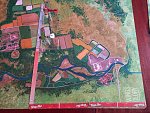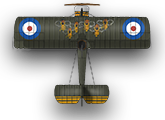OTT-FYM Mission 1: First Outing – 5th April 1917 by Hu Rhu
The weather started off misty and cloudy but it had improved enough to bring forth aircraft from both sides to do battle as the build-up towards the Arras offensive got into its stride. Every headquarters needed photos of all sorts of things, so the observation squadrons were ordered up. With the Germans having retreated to their new lines and the impending offensive against those new enemy positions - and the only maps came from photos - photo ops needed to be flown. It was also the day which saw the first operational sorties flown by the new Bristol Fighters, the BF2a.
The first flight consisted of 6 aircraft commanded by none other than Captain WL Robinson, who had won the Victoria Cross for shooting down the German Schutte Lanz airship SL11 over north London in Sep 1916.
Great things had been forecast for this new aircraft, however, at this stage of its development, it had been decided by Capt Robinson that, if attacked, the Bristols would merely close up and let the combined fire from the rear gunners force away the would-be attackers. (For an understanding of how well this tactic worked see the bottom section of the briefing – Historical Outcome).
Scenario
This scenario will attempt to re-create the conditions of that first combat, with the RFC aircraft using the correct doctrine of flying in close formation.
Mat Set Up
A No Man’s Land (NML) mat and a countryside mat (or any other type) that will be enemy territory; these are joined on the long sides with the trench map being on the western (left) side and countryside mat being on the Eastern (right) side.
Aircraft Starting Positions
Having spotted the enemy, the three Bristol fighters are set up in close formation in the centre of the two mats, with the lead aircraft just over the centre line and the other two aircraft in echelon to the left and right rear as shown on the photo.
If you don’t have three Bristol fighters, you can substitute either RE8, DH4 or Sopwith 1 ½ strutters, however the three aircraft must fly the same manoeuvre deck. The two seaters are to be armed with a single Vickers firing forward and a single Lewis gun to the reaer.
Three Albatros D.III approach with two planes to the southeast and one to the northeast of the Bristols. The northern aircraft is placed two rulers from the eastern edge and one ruler in from the northern edge. The other two aircraft are placed two rulers in from the eastern edge and one and one and a half rulers respectively, from the southern edge as per the photos.


Aircraft Restrictions
In line with the doctrine of the day, remove the Immelmann turn card from the S Deck (or equivalent).
Initially the Bristols will fly attempt to fly in close formation. To achieve this, select manoeuvre cards for the lead aircraft only, and apply to all three aircraft. Ideally select a manoeuvre that will place the attackers in the rear arc. This will reflect the attempt to fly in close formation using firepower to ward off the attackers. Only adjust cards for individual planes to prevent collisions when flying in close formation. (i.e. be the I in AI)
Only when the first Bristol is shot down or FRTB will the RFC aircraft then revert to being flown individually. Select cards for each remaining aircraft individually from the start of the next full turn.
There are no manoeuvre restrictions on the German aircraft.
Mission
Shoot down or force the enemy aircraft to return to base.
Victory Points
For each aircraft shot down – 10 points
For each aircraft FRTB – 5 Points
Historical Outcome
On the morning of 5th April six Bristol F2a of 48 Sqn led by Capt Robinson, took off from Bellevue at around 1000 hrs for an offensive patrol to Douai. Their base was over 40km to the front at Arras and by the time they had gained height, crossed the lines and were well east of Douai, it was nearing 1100 hrs. Having been reported by German ground observers, a telephone to Jasta 11’s base at Brayelles had von Richhtofen’s pilots taking off within minutes, led by the Baron himself.
Having spotted the Albatros scouts, the Bristol pilots closed up while the gunners waited for the range to decrease. Down came the five machines from Jasta 11, machine guns blazing. First one then another Bristol was hit, dropping out of formation. Von Richthofen singled out one flown by 2Lts Leckler and George which he engaged, finally forcing it down near Lewarde, south-east of Douai.
Having shot down one aircraft he then set off after the other four aircraft, Ltn Festner having already knocked down Robinson’s machine. He caught up with them over Douai and brought down Adams and Stewart near Cuincy, just west of Doaui. Ltn Georg Simon claimed the fourth, downed north of Monchecourt. The other two scraped over the lines, full of holes. They claimed two of their attackers shot down but Jasta 11 suffered no casualties.
The total tally was:
A3337 Capt WL Robinson VC POW 2Lt ED Warburton POW
A3320 Lt HA Cooper POW/WIA 2Lt A Boldison POW/WIA
A3343 Lt AT Adams POW/WIA Lt DJ Stewart POW/WIA
A3340 2lt AN Leckler POW/WIA 2Lt HDK George KIA






 Reply With Quote
Reply With Quote







 Thanks Gary!
Thanks Gary!





Bookmarks